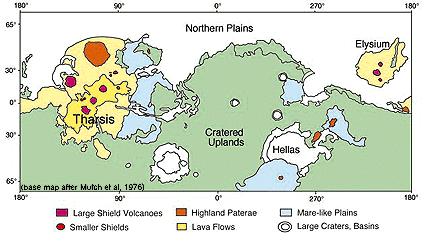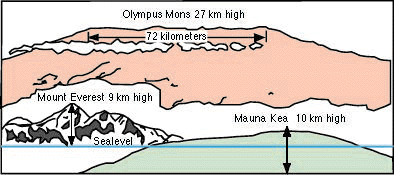The Surface and Geology of Mars

Mars Landscape
Mars has a single Plate (no `tectonics'), and two distinct terrains:
The Northern plains and the Southern Highlands. An enormous escarpment several
km high separates them. The Southern Highlands are rough and highly cratered,
being more than 3 billion years old. The North is much younger, with extensive
resurfacing, which happened about a billion years ago.
Mars retained much of its internal heat, unlike the Moon or Mercury, because it is larger. This explains the occurrence of young surface regions. The vast majority of volcanism occurs in the two regions, Elysium and Tharsis. Martian volcanoes are shield volcanoes, showing shallow slopes from tens of episodes of lava flow build up. It is similar to the way in which the Hawaiian Islands were formed.
 |
 |
Tharsis is the greatest volcanic region, rising 8 - 9 km above the rest and hosting Mars' greatest volcanoes (Olympus Mons). It sits upon an enormous mantle plume, and because there are no plate tectonics on Mars, Olympus mons simply grew and grew and grew to an enormous size. Mars must have a very thick lithosphere to be able to support such a massive volcano. An equally massive volcano could not exist on Earth.